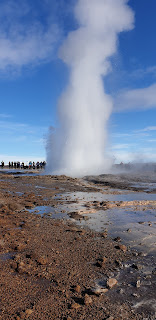southern peninsula region of Iceland
Southern peninsula region of Iceland was our next stop. It is a desolate region of lava rocks covered with snow but with a lot of geothermal springs which gives the country the ability to generate power using this hot water not only for domestic consumption but also for industrial plants. Southern Peninsula(Icelandic: Suðurnes) Reykjanesskagi(pronounced [ˈreiːcanɛsˌskaiːjɪ]) or Reykjanes Peninsu la is a region in southwest Iceland. It was named after Reykjanes, the southwestern tip of Reykjanesskagi. The region has a population of more than 25,000 (2018) and is one of the more densely populated parts of the island. The administrative centre is Keflavík, which had 7,000 residents when it merged with the nearby town of Njarðvík and Hafnir several years ago to create Reykjanesbær, which now (feb 2019) is the largest settlement outside the Greater Reykjavík area; on 1 January 2013 the town had a population of 14,231, but 17,805 in 2018. The region is the location of Keflav...




